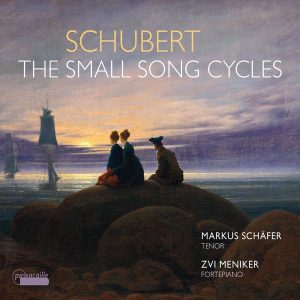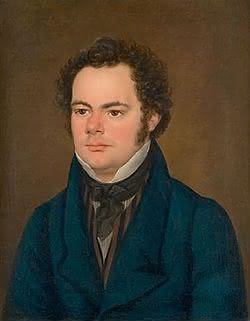 Como eu já falei aqui e aqui, para os meus ouvidos o som mais intimista dos instrumentos de época combina com o espírito romântico de Schubert… esse tipo de romantismo contido, sem exageros nem de alegria nem de melancolia.
Como eu já falei aqui e aqui, para os meus ouvidos o som mais intimista dos instrumentos de época combina com o espírito romântico de Schubert… esse tipo de romantismo contido, sem exageros nem de alegria nem de melancolia.
Neste álbum gravado nos Países Baixos em 2018, os intérpretes escolheram gravar alguns dos pequenos ciclos de canções publicados por Schubert, por isso mesmo com números de Opus (enquanto os números “D” foram atribuídos depois por pesquisadores). São muito comuns as gravações de canções avulsas, e não há nada de errado nisso, pois no século XIX também era comum cantarem obras avulsas e não necessariamente o ciclo inteiro. Mas aqui Markus e Zvi buscaram apresentar os ciclos na ordem que foi decidida por Schubert em conjunto com os editores de suas partituras. O encarte do álbum explica:
That these have remained for a long time totally unknown can be explained by the decisions and choices made by nineteenth-century music publishers. In the Old Schubert Edition, publication of the Lieder was based on their chronological order, whilst in the complete Peters edition the order was determined by the popularity of the works. The smaller song cycles arranged by Schubert himself were thus broken up completely. Only in the Neue Schubert-Ausgabe, edited by Walther Dürr, were the songs published according to the opus numbers.
The view held by Markus Schäfer and Zvi Meniker about these cycles is that “they were not planned on purpose, like Die schöne Müllerin or Winterreise, but were mostly songs that he wrote at different times and then found connections between them. He always composed according to his mood, without planning in advance. Not like Mozart, who worked on commission or with the prospect of a performance, or like Beethoven with an eye on publishing, but simply by inspiration. Schubert got the spark, and then he wrote. Therefore, every song, no matter how short, is a gem. Hence the many unpublished songs; and he often grouped the songs together quite a long time after their composition, just for publication. There is a clear development in each cycle, each one has a direction, a beginning and an end. Each cycle has a theme, even if it’s a bit hidden sometimes.” That said, there are a number of opera which were conceived as cycles from the outset, for example the Drei Gesänge des Harfners (Op. 12), with texts drawn from Goethe’s novel Wilhelm Meisters Lehrjahre. This is also the case of the Refrainlieder (Op. 95), which were probably composed in June 1828 and were published on August 13 in the same year.
A good number of these smaller song cycles were developed by Schubert around a particular subject. For example, the Op. 5 set consists of five songs to poems by Goethe whose central theme is love. Whilst this opus was put together in 1821 for the publishers Cappi and Diabelli, the Lieder which make it up were composed in 1815 and 1816.
Franz Schubert (1797-1828):
1-5. Fünf Lieder op. 5 (1821), sobre poemas de Johann Wolfgang von Goethe
6-8. Drei Lieder op. 12 (1822), Drei Gesänge des Harfners aus “Wilhelm Meister”, sobre poemas de Johann Wolfgang von Goethe
9-12. Vier Lieder op. 59 (1826), sobre poemas de August von Platen e Friedrich Rückert
13-15. Drei Lieder op. 65 (1826), sobre poemas de Johann Mayrhofer e Friedrich von Schlegel
16-18. Drei Lieder op. 80 (1827), sobre poemas de Johann Gabriel Seidl
19-22. Vier Refrain-Lieder op. 95 (1828), sobre poemas de Johann Gabriel Seidl
MARKUS SCHÄFER tenor
ZVI MENIKER fortepiano after Conrad Graf, Vienna 1819, by Paul McNulty, Divisov 2012

Pleyel